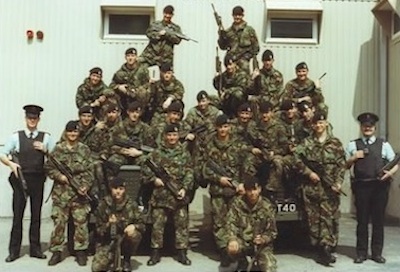
Recently discovered secret documents have revealed that the British Army’s Ulster Defence Regiment (UDR) had primacy over other British army units in some areas of the north during the conflict.
The revelation is contained in a booklet launched by the Pat Finucane Centre this week.
‘The Hidden History of the UDR: The Secret Files Revealed’ also confirms the extent of collusion between some members of the locally recruited regiment and loyalist paramilitary groups during the 1970s and 1980s.
The report finds that British officials believed the regiment “acted as a political safety valve for the government by reassuring some Protestant politicians”.
All the information contained in the document has been gathered from official British government reports and Ministry of Defence files.
Formed in April 1970 to replace the notorious ‘B’ Specials, the UDR’s membership came mainly from the Protestant community.
Former SDLP councillor Brian Feeney, who has written the foreword to the research, said that during the conflict between five and 15 per cent of the regiment’s members were also involved with loyalist paramilitary groups.
He believes that these dual members, many of whom were also RUC Special Branch and MI5 agents, provided weapons, intelligence and finance to loyalist paramilitary groups.
While much is known about the extent of UDR collusion with loyalist groups, the full extent of the regiment’s ability to dictate to other British army units in some parts of the north has not been made public.
One document uncovered by the Pat Finucane Centre and marked “secret” reveals that UDR commanders had authority over regular British troops in many areas.
The briefing document was prepared for a meeting at Stormont involving British military officials in 1980.
The document reveals that the regiment was deployed across the north with the exception of west Belfast, south Armagh and “west of the Foyle” and provided “frontline support to the RUC”.
The report refers to government papers confirming the UDR was given “Tactical Areas of Responsibility”.
“In these areas the UDR Battalion Commander is the local military commander, and any regular troops deployed there, other than large numbers brought in to deal with a state of public disorder, come under UDR command,” it said.
The booklet also looks at the level of collusion between the regiment and loyalists groups.
Referring to the 2012 de Silva report into the murder of human rights solicitor Pat Finucane, the latest re-search reaffirms how the collusion probe concluded that 85 per cent “of all the information acted upon by loyalist paramilitaries came directly from the security forces”.
The secret briefing paper also revealed how British authorities viewed the UDR.
“The deployment of part timers has enabled civilians, largely Protestants who had long been accustomed to the existence of some sort of part-time security force, to play their par in combating terrorism.
“This has acted as a political safety valve for the government by reassuring some Protestant politicians...”
Paul O’Connor from the Pat Finucane Centre said the research “demolishes once and for all the ‘bad apple’ argument” that collusion was not widespread.
“Government ministers and senior generals were well aware that the UDR served as a safety valve for loyalist paramilitaries,” he said.
![[Irish Republican News]](https://republican-news.org/graphics/title_gifs/rn.gif)
![[Irish Republican News]](https://republican-news.org/graphics/title_gifs/harp.gif)

